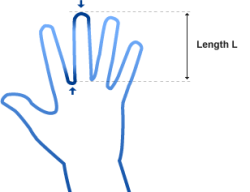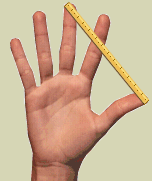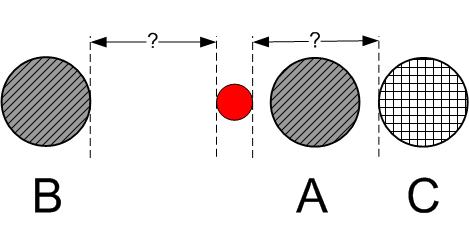I’m beginning to suspect that most of the traditional advice on how to select boule size is bogus, and that many players may be playing with boules that are too big.
- The traditional advice and its problems
- Do shooters really play with bigger boules? Not any more.
- What happens when you play with boules that are too big?
- The solution — smaller boules
The traditional advice and its problems ▲
There is one question that all petanque players confront when purchasing competition boules — “What size should I purchase?”
There are two different schools of thought (theories, really) about how to select the size of boules.
- The Role-based Theory is that “It depends on what kind of player you are. Small boules for pointers, because small boules make small targets for shooters. Big boules for shooters, because a bigger missile is more likely to hit its target.”
- The Hand-size Theory is that “It depends on how big your hand is. Small boules for small hands. Big boules for big hands.”
There are problems with both of these schools of thought.
The Role-based Theory is useless for the average player. Beginning players aren’t yet skillful enough to classify themselves as pointers or shooters. Sometimes they will need to point, and sometimes they will need to shoot. The division of players into pointers, middle-men (millieux), and shooters really makes sense only for world-class players playing triples.
The idea that a boule is a more difficult target, or a more effective missile, because its radius is one millimeter less or more than some other boule… well, that’s just ludicrous. It’s like telling a Marine sniper to use a larger caliber bullet so he’ll have a better chance of hitting his target. Or telling a fat dictator that he needs to lose weight so he’ll present a small target for an assassin.
Most damaging to the theory, though, is the fact that the whole idea is questionable. A big wheel is better than a small wheel at rolling over lumps and bumps in its path. That’s why bicycles have bigger wheels than roller skates. So you’d think that a pointer would want to play with larger, not smaller, boules. Byron Putman reports that “Many club players contend that a pointer should use the largest boule that he can comfortably throw.” [Petanque, p. 103] Conversely, it would seem sensible for a shooter to prefer a smaller, not bigger, boule. One would think that being able to really wrap your fingers around a smaller boule would give a shooter more control over the boule.
You see the problem here. These ideas are just theories that somebody came up with because a priori they seemed to make sense. But completely opposite theories also make sense. They are all just theories. They have no basis in actual facts. That’s what makes them bogus. As Byron Putman says, “Be skeptical of most club-level boule selection advice… because it is often based on urban myth and contradictory inferences.”
In contrast to the Role-based Theory, the Hand-size Theory seems practical and sensible. There is obviously a relationship between the size of a hand and the size of a boule that will fit comfortably into that hand. So the slogan “Small boules for small hands; big boules for big hands,” seems to make sense.
The problem lies in the practical application of the theory. Boules manufacturers have tried to create formulas based on this idea (“a player with hand-size X should use boules of size Y”). But the numbers in their formulas are questionable, if not downright bogus.
 The first sign that something is fishy is the fact that different boules manufacturers offer different ways to measure your hand. In theory, if there was a specific feature of a hand that made a boule more or less suitable for that hand (the length of the fingers, for instance) then everybody would know that, and all boules manufacturers would ask for the same hand measurement. But they don’t. Some measure the length of the middle finger from the hand to the finger tip. Some measure the distance from the base of the hand (the wrist) to the finger tip. Others measure the distance from the tip of the thumb to the tip of the middle finger. (Read our post on the various methods.) There is, in short, no standard formula for measuring hand size. Nobody really knows what should count as “a small hand” or “a big hand” for the purpose of picking boules.
The first sign that something is fishy is the fact that different boules manufacturers offer different ways to measure your hand. In theory, if there was a specific feature of a hand that made a boule more or less suitable for that hand (the length of the fingers, for instance) then everybody would know that, and all boules manufacturers would ask for the same hand measurement. But they don’t. Some measure the length of the middle finger from the hand to the finger tip. Some measure the distance from the base of the hand (the wrist) to the finger tip. Others measure the distance from the tip of the thumb to the tip of the middle finger. (Read our post on the various methods.) There is, in short, no standard formula for measuring hand size. Nobody really knows what should count as “a small hand” or “a big hand” for the purpose of picking boules.


You encounter the second bit of fishy business when (having measured your hand) you consult a manufacturer’s table that maps boule size to hand size. Suppose you measure your hand and get a measurement of X centimeters. And suppose that the table says that someone with that hand size should play with a boule of 74mm. But where did they get that number of 74mm? Could that number be wrong? With a hand size of X cm, perhaps you should be playing with a 71mm or 72mm or 75mm or 76mm boule. How do we — or they — know what size boule a person with an X-centimeter hand should use?

Steve Ferg (left, USA) and friend Daniel Duflot (right, France). Steve plays with a 74mm boule. Daniel uses a 75mm boule.
- In the USA, a boule size of 73 mm seems to be the average for men, with smaller sizes such as 71 mm being popular with women. In France on the other hand, the most common diameters for men are 74–75 mm, and for women 72–73 mm.
- Generic Chinese leisure boules of the kind that you might buy from Petanque America are about 73 mm, but Obut (French) leisure boules are 74 mm.
- Since French players are probably on average smaller than American players, why are they using bigger boules?
And if French players prefer larger boules than Americans, and French boule manufacturers design their size-selection guidelines with their largest market (French players) in mind, then the size-selection guidelines provided by French manufacturers will tell Americans to buy boules that are too large. So why should American players follow the advice of French manufacturers?
When I used the hand charts, they said that I should play with a big boule — 76mm. Despite my gut feeling that that was too large, I went ahead and bought 76mm boules. Why?
- Partly, it was because I was new at the game, I knew that I didn’t know much and I assumed that the boule manufacturers knew their business. As an ignorant newbie, I accepted established authority.
- Partly, there was some stupid macho bullshit rattling around in my brain — the kind that equates “big” with “strong” and “manly”. And the fact that I actually am a tall guy helped me not to recognize the macho bullshit for the bullshit that it was.
- But the strongest reason was the Role-based Theory. I wanted, some day, to become a really good petanque player, i.e. a shooter. So, I reasoned, I should buy shooter’s boules — big boules. The Role-based Theory led me, an aspiring shooter, into playing with boules that were too big.
I suspect the same kinds of things happen to other players.
Do shooters really play with bigger boules? Not any more. ▲
On Youtube, there is an interesting video of a clinic that Claudy Weibel gave at the 2012 Petanque America Open. After the clinic, during the question-and-answer period, one gentleman asks Claudy “When do you know that the boule is too big for a shooter? Because when we shoot, we like big boules, but what is too big?” And a bit later in the video we can see him with a boule in his hand, and it looks too big. It is pretty clear that he has been playing with, and having trouble with, a boule that is too large for his hand, and that he’s been doing it because of the tradition that shooters play with big boules.
Claudy’s answer is interesting. You can watch the video on YouTube, and I have made a transcript of the conversation (below). Note that Jean-Pierre Subrenat (president of the New York Petanque Club, and a very strong player in his own right) is translating for Claudy, and sometimes he offers his own thoughts as well as Claudy’s. The conversation begins at 12:15.
QUESTION:
When do you know that the boule is too big for a shooter? Because when we shoot we like big boules, but what is too big?ANSWER:
It’s totally the contrary. Me [Claudy], I play 73. I [Jean-Pierre] used to play 75. Now I play 72.A shooter doesn’t have to have big boules to shoot. On the contrary, you have to control the boule in your hand. [When you play with a smaller boule,] when you release the boule, you release it better, you can control it better with your fingers.
[Jean-Pierre, talking to the student:] I think this boule is too big for you, just by looking at your hand.
[They examine the boules. The student says that he thinks his boule is 76 or 77. Claudy compares his hand to the student’s hand. The hand sizes look to be about the same. Claudy says that he plays with a 73. The implication, of course, is that the student is probably playing with a boule that is about 3mm too big for him.]
I [Jean-Pierre] was playing 75, then with my team we got sponsored by KTK, the brand, and when they gave me the boules, I said I want 75. They said no, all the big players are playing with smaller and smaller boules. Quintais plays with 71. 71! And he’s bigger than you!
Yeah, the smaller… And that is a trend that is new. When you think that Quintais plays with boules that are smaller than my 72, its amazing, the results that he has.
When you point, you can control the smaller boule ten times better. All these years, I went from 75 to 72. I cannot play now with 75, at least not any more, at least not decently.
Dylan [Rocher] plays with 73. Marco [Foyot] plays with 74. Damien [Hureau] plays with 73.
QUESTION: So it’s a trend then?
ANSWER: It’s a trend. It’s the results… you see the results!
At the very end of the video Claudy makes some remarks in French that Pierre does not translate. I think I hear “It is important to have a good grip on the boule in the hand (bonne tenue en la main).” And later, something about “leaving the hand well (bien sortir en main).”
The bottom line is that Claudy and Jean-Pierre think that the old orthodoxy of “big boules for shooters” is dying. The new thinking is “Not too big. You can control a smaller boule better.”
I recently discovered more support for this idea. On August 16, 2014, there was an interesting post on one of the forums of the petanque710 web site. Its subject was diameter of the boules of shooters (Diamètre des boules des tireurs). Here is my rather free translation of the post.
When I started playing petanque I noticed that the majority of the players, and especially shooters, played with boules of 75 or 76 mm in diameter, with 75mm being the most used. But now I notice that small diameters (72-74) are being used, with diameters of 75 and 76 now being quite rare in games. And even more surprising, many of the great shooters are playing with the small diameters.
So I decided to make a list of the diameters and also the weights of the boules that the great players are now using. If you find any errors in my list, you can correct them and add other names to the list.
- 74 – 700 – Foyot
- 74 – 700 – Miléi
- 74 – 690 – Quintais
- 74 – 680 – W Chapeland
- 74 – 680 – Fred Michel
- 73 – 690 – Weibel
- 73 – 690 – Savin
- 73 – 690 – J L Devernois
- 73 – 690 – Gasparini
- 72 – 680 – Dylan Rocher
- 73 – 680 – S Chapeland
- 73 – 680 – J Darodès
- 73 – 680 – Dufeu
- 73 – 680 – D Olmos
- 72 – 700 – Suchaud
- 72 – 680 – Maillard
- 72 – 680 – Leboursicaud
- 71 – ??? – Christian Fazzino
- 71 – 700 – Gross
- 71 – 680 – A Papon
The result, as you can see, is something that might seem strange. Almost all of the top female and male shooters in the world play with 71 and 72mm — the smallest diameter.
The original post (which has now been taken down) reported Marco Foyot playing with 76 and Dylan Rocher with 72. I've changed their information based on Jean-Pierre Subrenat's comments, which I consider more reliable because I know that he has personally played against Marco and Dylan. I've left other contradictions unchanged (e.g. the list reports Quintais as playing with 74, but Jean-Pierre reports him as playing with 71). Note also that the closing remark that the top shooters play with 71 and 72 is contradicted by the list information. According to the list, most are using 73, with about an equal number split between 74 and 72/71.
What happens when you play with boules that are too big? ▲
 There seem to be two consequences of throwing boules that are too big. One is accuracy issues, and the other is forearm fatigue and soreness. These problems occur with notable regularity among women players, who as a group have smaller hands than male players.
There seem to be two consequences of throwing boules that are too big. One is accuracy issues, and the other is forearm fatigue and soreness. These problems occur with notable regularity among women players, who as a group have smaller hands than male players.
Byron Putman, in his book Petanque, notes that many players compensate for throwing oversized boules by unconsciously pulling their fingers apart. There may also be undesired thumb friction. The result is that players throwing oversized boules often have chronic issues with undesired sidespin (causing non-linear rollout) and release hang-ups (which can cause difficulties in controlling the distance of a throw). [pp. 75-77]
In addition, a larger (or heavier) boule requires a greater gripping force. The player must squeeze the boule harder in order to hold it. The squeezing tightens the forearm flexor muscles, producing forearm fatigue and soreness. I’ve had a friend — a small lady player — tell me that she experiences forearm soreness. And Carl Herbert, of the Seattle Petanque Club, reported the same thing in a recent email exchange.
Yes, I believe you are correct that Americans use bad advice for selection of boules. After six months of playing daily with boules that caused my forearm to ache, I tried using smaller boules and found I shoot more accurately with them. I suspect I point better with smaller boules as well… I play mostly with a set of 71mm 650g boules now, and I like them very much.
The solution — smaller boules ▲
The obvious solution to the problems of boules that are too big, is to play with smaller boules. Byron Putman found this to be especially true for the women players in his group. [Petanque, pp. 104-5]
The minimum certified boule size is 70.5mm. According to the boule sizing chart a 71mm boule equates to the hand measurement between 170mm and 180mm. I’ve measured the hands of over 50 women with a variety of heights and bone structures. The average thumb to middle finger span is about 163mm which, according to most sizing charts, would specify a 69mm boule!
Putman tells the story of a female friend with a very small hand who suffered “chronic release issues” while using 71mm, 680g boules. Her release issues vanished when she switched to “competition junior” boules of 70.5mm, 650g.
Even 1/2mm and 30g can make a huge difference to a player with petite paws… Of the 12 regular women players in my summer group, eight of them throw [compet. juniors] — and they absolutely love them!
During my email conversation with Carl Herbert, he wrote
I think there is better advice to give newcomers than what I got myself. I feel strongly clubs should provide a range of boules for new players, especially smaller sizes. Many clubs provide only the 73mm Chinese-made boules or the 74mm Obut leisure boules for lending to beginners, and I think that is a grievous error. They start out hindered even before they know how to play the game.
I see a lot of new players buy Obut leisure boules because they are relatively inexpensive, but many women who start with such large-diameter boules have trouble with them. B.W. Putman mentions in his book that women in his area who play with junior boules (70.5mm, 650 to 670 grams) like them and play well with them. I like them too! I have yet to hear a reasoned explanation why anybody can’t play with smaller, lighter boules to good effect. Indeed, my experience has been that I generally play better with them.
Perhaps I will experiment again with larger-diameter boules in the future, but I expect I will always find smaller-diameter boules more precise. One reason is that boules with a relatively smaller fit within my hand permit me greater variation in my grip. The tactile variability of the boule in my hand allows me better consistency in how I grip it. I have a better feel for minor differences of my grip.
I started with my 71mm, 650-gram boules this past January after having played with 72mm boules for a few months. I had played with a set of junior boules during a visit to California, and I liked them very much. My benefit was immediate and considerable.
I suggest new players are better off starting with boules in the 70.5mm to 72mm range unless they have very large hands. Even then there’s no reason they can’t play the small boules for a while. I suggest it is better to start small and move gradually to larger sizes than it is to use the various selection guides to guess compromising sizes to suit an ideal skill level that players may attain in the future. The latter approach probably costs a player more money and accumulates more steel boules in their closets.
I can certainly identify with that last sentence. I have several sets of 76mm boules that are going up for sale on eBay one of these days.
In summary… There are good reasons to suspect that the traditional advice about boule size tends to steer players toward selecting and playing with boules that are too large. If you are having consistency or accuracy issues with your throwing, or are experiencing tiredness or soreness in your forearm, you should probably consider experimenting with a smaller size of boule.
▲

